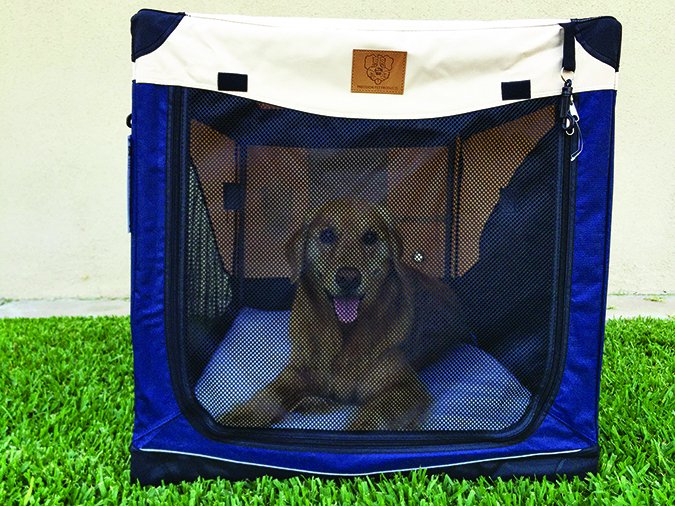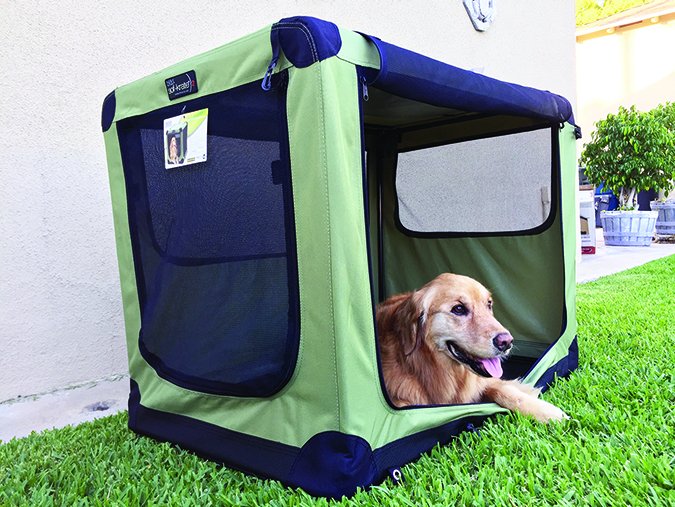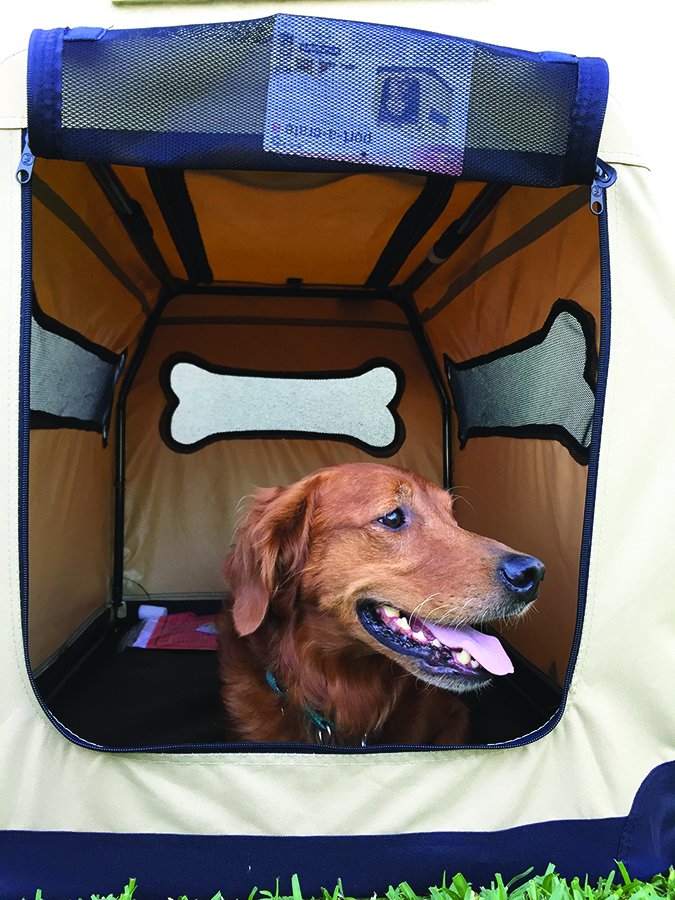Crate training offers a variety of benefits. The crate is a useful training tool to help teach housetraining skills, manage over-arousal, and protect against unwanted destruction when owners are unable to supervise an untrained dog of any age. A crate-trained dog always has a familiar retreat to call his own, whether at home, when travelling, or while waiting his turn at a weekly training class or performance event.
Not that long ago, crates were typically limited to bulky plastic or wire enclosures that were cumbersome to move from place to place. Today, dog owners have many choices when it comes to portable containment options, including a growing market of lightweight, foldable “soft crates” that are easy to transport from place to place.
Skip to the dog crate review chart.

Is a Soft Crate Right for Your Dog?
As a trainer, I feel strongly that soft crates are meant to be used only by dogs who are already reliably crated trained. Confining a puppy or non-crate-trained adult dog using a soft crate is, in my opinion, just asking for trouble. No matter how the soft crate is constructed, canvas and mesh just aren’t designed to withstand the expected clawing and biting that often accompanies a puppy or young dog’s attempts to exit a crate without direct invitation. Until I have solid knowledge of my dog’s ability to crate calmly, I use a sturdy plastic kennel at home, or an exercise pen or collapsible wire crate for travel.
Some well-crate-trained dogs have even been known to free themselves from a soft crate in a moment of circumstantial excitement or frustration. My very first soft crate has a memorable Whippet-head-shaped hole in the mesh door from when its then inhabitant, Zoie, decided she’d had enough of sitting in the crate while I ran her housemate in a dock jumping competition. My current Golden, Saber, once left his mark of disapproval on the zipper seam of another soft crate when he decided it wasn’t right to be left behind when I had to go lead a group training adventure. He likely heard the group outside – comprised of many of his favorite people – and the damaging scratching ensued. I considered both dogs to be reliably crate trained, and both dogs had crated successfully, in soft crates, in similar situations, prior to their escape attempts. But sometimes mistakes happen.

In some cases, mesh damage can be repaired using a screen-mending kit or with some creative sewing. Several manufacturers also sell replacement covers – however, replacement covers often cost almost as much as a new crate.
Like most any dog product, it’s important to know your dog. In the wrong hands (er, paws!), a soft crate can be an expensive experiment. But if your dog is truly ready for the experience, soft crates are perfect when you want something easily portable.
Advantages of a Portable Dog Kennel
Virtually any soft crate is going to come out on top in terms of portability when compared to a traditional plastic crate, collapsible wire crate, or exercise pen. Visit any competitive dog event or training class and you’ll find a sea of soft crates in all shapes, sizes, and styles. By design, soft crates weigh considerably less than plastic or wire crates of a similar size. Generally speaking, they also tend to fold flatter than collapsible wire crates. Each of these factors combine to make them a great choice for dog owners who need to frequently set up and break down their crate.
A soft crate also works well for home-based situational crating. The small footprint when folded makes it easy to tuck the crate away in a closet or under the bed if you only use it occasionally, such as when certain visitors stop by, when restricting a dog’s activity as she recovers from an injury, or when traveling.
While a soft crate is highly portable, we recommend against their use as travel crates in the car. Most any crate or pet seatbelt system helps protect against a dog interfering with, and dangerously distracting, the driver, making it a better choice than riding loose. However, the amount of force generated during even a minor collision could potentially catapult a dog through the mesh panels of most (if not all) soft crates.
Soft Crates: Most Important Features
When I’m shopping for a soft crate, I look for supreme ease of use, both in terms of how quickly I can set up and break down the crate, and how easy it is to carry to my designated crating area at weekly dog classes and events. I also want my dog to fit comfortably in a crate recommended for his size.
I almost always use the soft crate at outdoor events, so good ventilation is important. I want a product that is sturdy enough to support a few assorted training items on top, so I can use it as a temporary table while I train. And, because I know “dogs can be dogs,” and even the best crate-trained dog will occasionally manage to damage the crate beyond repair, I don’t want to spend a lot of money on a soft crate.
How We Reviewed the Dog Crates
We chose a total of eight crates for review. Some were selected based on recommendations by fellow dog enthusiasts; some because they are made by manufacturers of well-known wire crates and exercise pens, and some based simply on Google search results and/or an inexpensive price tag.
After carefully analyzing the pros and cons of each crate, we saw a lot of really wonderful features, but, sadly, not one single crate managed to offer all of our favorite features in one product. (Hey, manufacturers, call me!) Still, it was pretty easy to come up with a couple of overall favorites, a least favorite, and some honest feedback about the pros and cons of the remaining crates, which we hope aids in readers’ decision making.
2017 Soft-Sided Crate Reviews

Our 4-PAW Favorite Soft Crates
We found just two crates that met our criteria for a four-paw rating (the highest rating we confer on any products).
Elite Field’s Three-Door Folding Soft Crate
Elite Field’s Three-Door Folding Soft Crate (pictured above) was the standout leader in terms of available features and overall value. We reviewed the 36-inch version, which measures 36 inches long by 24 inches wide by 28 inches tall. Most notable was the additional headroom, making it more likely the crate’s inhabitant can sit comfortably while maintaining a natural head position.
This crate packs a punch with its features. The crate quickly takes shape after unfolding by easily connecting both ends of the lightweight internal steel-tube frame, accessible via a zippered, mesh “sunroof” panel on the top of the crate. Set-up and break down can be done in seconds. After releasing the frame, the crate quickly folds into itself and is held in the folded position with two quick-release buckles.
The crate cover, made of thick canvas and sturdy mesh, can be removed and washed, if needed. The Elite Field soft crate features rounded, reinforced corners and feels sturdy when set up. The 36-inch crate weighs 14 pounds.
We appreciate how this crate has front and side entry doors, along with one full-length mesh window on the opposite long side, and a partial mesh window on the short side. The zippered side entry is helpful when you need to position the crate sideways, which then restricts access to the front door. (I sometimes run into this issue in hotels.)
The sheer amount of mesh means this crate is well ventilated, making it a wise choice for use in warmer climates. While not shown on the manufacturer’s website, the crate is also available, in specific colors, with “curtains” that can be rolled down to cover the mesh door and windows. This is a nice feature for times when obstructing a dog’s view helps reduce over-arousal and related vocalization.
Elite Field has thrown in several value-added features, such as storage pockets on both the top and short end of the crate, and the crate comes with a free mat and carrying case. I’m personally not a fan of encasing my crate in its own bag when not in use, so I was pleased to see the crate itself has multiple built-in handles, making it easy to transport even when out of its case. If anything, Elite Field almost went overboard with carrying options. Not only is there a handle for carrying the crate when folded, every size crate also comes with a cross-tied handle on the top of the crate. I could see using this option if carrying the small-size crate while occupied by a small dog, but definitely not while housing a dog in one of the larger size crates.
Our one notable disappointment with this crate is the inability to secure the zippers in the closed position. As someone who has spent countless weekends at dog events, I know how quickly clever dogs can figure out how to open a zippered door by positioning a toenail “just right” on the frame of the zipper pull. Many soft crates come with a small clip just above the zippered door. The clip can be used to “lock” the zipper, thus thwarting a clever dog’s attempt to open the zipper with his claw.

Firsttrax Noz2Noz Sof-Krate
A close second to the Elite Field crate is the Firstrax Noz2Noz Sof-Krate. We tested the 42-inch crate, which measures 42 inches long by 28 inches wide by 32 inches tall. This crate is similar to the Elite Field crate, but without the bells and whistles of storage pockets, a crate mat, or a carrying case.
Like the Elite Field crate, set-up involves pulling both ends of the internal frame into position, where they fit together and are secured by a closure sleeve. Set up can be done in seconds. The crate cover, made of thick canvas and sturdy mesh, can be removed and washed. Replacement covers are available from the manufacturer. The Noz2Noz Sof-Krate soft crate has reinforced, rounded corners and feels sturdy when set up. The 42-inch crate weighs 19 pounds.
This crate also features front and side-entry, mostly mesh doors and a canvas “sunroof.” We were pleased to find “zipper lock” clips on both the front and side access doors. The remaining long- and short-sides of the crate have mesh windows, allowing for maximum air-flow. The Noz 2 Noz crate folds down similar to the Elite Field crate. The folded crate can by carried by a single handle.
3-PAW Crates
Only one product was close enough to our higher-rated crates to earn our three-paw rating.
A solid, no-frills, functional choice:
Firstrax Petnation Port-a-Crate E-Series

Firstrax also manufactures the Petnation Port-a-Crate E-Series. The lightweight, internal frame works similar to that of the Elite Field and Noz2Noz crate, and the Petnation Port-a-Crate can be set up or taken down in seconds. Of the three similarly designed crates, the Port-a-Crate appeared to fold down the flattest. Its overall shape is slightly different; the top of the crate tapers inward, but not so much as to significantly limit the dog’s usable headroom.
We tested the 36-inch crate, which measures 36 inches long by 25 inches wide by 25 inches tall, making it one of the shorter crates (at that length) in our review. Unlike the 36-inch Elite Field crate, my Golden Retriever, who measures about 21 inches at the shoulders, cannot sit with a natural head position in this crate. This doesn’t bother me, as I prefer my dogs to lie down and rest when in their away-from-home crates, but it’s worth noting, especially if your dog is on the taller side. The 36-inch Port-a-Crate weighs 14.5 pounds.
Aside from the shorter height, the only other potential issue we saw with the Port-a-Crate is the window design. Unlike the Elite Field and Noz2Noz crates, which feature large mesh windows, allowing for significant ventilation, the Port-a-Crate is limited to a mesh front-entry door (with an available zipper lock) and small, bone-shaped windows on the remaining sides. This potentially limits airflow within the crate, an important consideration if used outdoors in hot or humid climates.
On the other hand, less mesh overall might also mean fewer areas for the dog to damage with his claws. Of the three similarly designed crates, we found the Port-a-Crate, available in six sizes, ranging in price from $32-$57, to be least expensive. At this price point, we recommend the Port-a-Crate as a nice “starter” soft crate if you aren’t sure your dog is ready to be contained by mere mesh and canvas.
2-PAW Products
The next three crates on our list failed to impress us overall, yet still have some notable features making them worth mentioning, as your priorities might differ from ours.
Go Pet Club Soft Pet Crate
If your your dog needs a little more room to relax, you appreciate a super-lightweight product, and know you can trust your dog in a soft crate, the Go Pet Club Soft Pet Crate might be worth a look.
Unlike our three favorite crates, which feature interior metal frames and a canvas/mesh cover, the Go Pet Club Soft Crate is made from heavy-duty, PVC-backed polyester. The entire crate literally zips together and holds its shape thanks to zippers and flexible spine strips encased in the crates rounded top. It’s not difficult to set up or break down, but it does take longer than any of our top picks.
The Go Pet Club Soft Pet Crate comes in a surprising assortment of sizes, ranging from 17.5 inches to a considerable 48 inches in length. In looking for a mid-size crate of this model, we had a choice of 32 inches or 38 inches. The 38-inch crate is exceptionally roomy, with a width of 28 inches and measuring a full 34 inches at the highest point of the rounded top.
The lack of an internal metal frame means this crate weighs just 12 pounds and folds down to about two inches thick and stores in an included case. However, the lack of a solid internal frame makes the crate less sturdy overall, and the three mesh windows and mesh front entry door (which work together to provide nice ventilation) appear to be made of lighter-weight mesh than the other brands we reviewed.
This crate’s biggest “pro” is its generous dimensions. If your goal is to secure the most internal real estate for the price, the Go Pet Club Soft Pet Crate could be a good option.
If you miss your old Cabana Crate:

Precision Pet’s Soft Side Pet Crate
A decade ago, WDJ’s top pick in soft-sided crates was a product called the Cabana Crate. For reasons that escape us, the product was discontinued long ago. The Precision Pet (recently purchased by PetMate) Soft Side Pet Crate resembles the Cabana Crate of yore, with some differences. It’s an attractive crate with a nice assortment of features, such as front and side-entry doors, storage pockets, non-skid feet, a water bottle opening and holder (for a ball-tip style water bottle), and a crate mat and carrying case. The canvas and mesh are of a nice quality, and the design appears to allow for desirable airflow.
Like many of the other crates we tested, this crate takes shape via a lightweight metal frame. However, of all the similarly designed crates we explored, the Soft Side Pet Crate took the longest to set up. Assembly reminded me of the discontinued Cabana Crate: first remove the crate’s cross bars from their self-fastening ties and swing them into position along the front and back (short sides) of the crate. Next, align the twist handles with the corner holes and turn the handles until fully engaged and secure.
This process is not at all difficult, but it does take longer, and it’s easy to become spoiled by the even-faster set up of the other crates we tested. Who wants a bulky old CRT TV version of a soft crate when the sleek flatscreen TV variety of crates are out there?
We also found it odd that the side entry door, when unzipped, flips out, not up, creating what looks a bit like an attached doormat rather than being kept out of the way by resting atop the crate.
In short, there’s nothing wrong with this crate, but the additional steps required for set-up and break down kept this option off of our “favorites” list.
A neat idea, but use it wisely:
Sport Pet’s Pop Crate

Pop goes the soft crate! If small and lightweight are your top priorities, and you have a medium-size, exceptionally well crate-trained dog who needs crating for just short periods of time, consider the Pop Crate by SportPet Designs.
Unlike every other crate we tested, the Pop Crate has no internal frame of any kind. The crate consists of two plastic ends – one with a spring-loaded metal door similar to a traditional plastic crate, and one with a full panel of air vents – connected by a rectangle of thin polyester fabric and mesh. To be sure, it wouldn’t take much effort at all for a dog to claw or chew his way through the fabric if he were so inclined. I’m not even positive the crate wouldn’t tip over if a large dog were to rest his weight against the side.
This crate’s claim to fame is its unique twisting design. Unclip the quick-release buckles and the crate springs into shape. To close the crate, stand it on end and twist the front frame 180 degrees, which compacts the crate back onto itself much like a pop-open car window shade.

The Pop Crate comes in two sizes, neither of which is very big, making this, in our opinion, a poor choice for dogs much larger than a Shetland Sheepdog. Also, while we like the use of the plastic frame and metal door (adding durability to a commonly chewed and clawed area), the location of the door hinge makes the already tiny opening even smaller. My dog startled himself more than once by hitting the door or doorframe on his way in and out of the crate. It’s also so lightweight (the large only weighs 6.35 pounds), it easily slid around on my hard floor with each entry and exit, again, startling my dog.
The large Pop Crate measures 36 inches long by 20.75 inches wide by 22 inches tall. The small Pop Crate is significantly smaller, measuring 22.5 inches long by 14.25 inches wide by 14.5 inches tall. Both collapse to 4 inches high, making it reasonable to pack in a suitcase for travel.
Elite Field’s Two-Door Soft X-Pen
In selecting products to review, we expanded our definition of “soft crate” to include what is best described as a fully enclosed, soft exercise pen. Like a traditional exercise pen, Elite Field‘s Two-Door Soft X-Pen consists of eight connected panels, only in this case, the panels are constructed of canvas and mesh. These create an octagonal enclosure with a diameter of 36-62 inches and a height of 24-36 inches.
We tested the 48-inch pen, which provided plenty of room for two adult Golden Retrievers. The pen has two zippered doors, two storage pockets, a water bottle opening and holder, and a removable (zippered) washable floor mat and mesh top. It’s lightweight and comes with a carrying case. Having recently refinished my hardwood floors, I loved the idea of a soft pen.

Elite Field’s Two-Door Soft X-Pen seemed like a strong contender as a top pick until it was time to fold it up. It does not come with detailed instructions, nor is it super intuitive. Even after we determined the need to remove the top and bottom of the pen before folding (a disappointment in itself), it took several attempts to discover the correct order in which to fold the panels onto themselves.
When we contacted the manufacturer for input as to the best way to fold the pen, we were told see the set-up instructions (which basically say, “unfold the play pen and expand the play pen”) and then to “please just reverse the set up process.” Gee, why didn’t we think of that? #Sarcasm.
This pen has a lot of potential. If Elite Field would number the panels and add simple instructions for folding it up, this pen could rise to the top of our list. We love the concept, but don’t recommend this product if you plan to set it up and take it down often, or if you have low frustration tolerance!
1-PAW Dog Crates (Lowest Rated)
The following crate might offer some utility for some dog owners, but didn’t, in our opinion, possess enough positive features to outweigh the factors we considered to be drawbacks.
Midwest Pet Product’s Canine Camper
Midwest Pet Products is a key player in the wire crate and exercise pen market. Unfortunately, it brought a wire crate mindset to the soft crate market, with (in our view) a poor result.

The Canine Camper is essentially a sparse wire crate encased in canvas. On the outside, it looks similar to any of the soft crates held together by lightweight metal frames. Underneath the attractive canvas cover is a wire frame, which requires a somewhat counterintuitive, two-step process to secure.
To add to the challenge, unlike similar soft crates where assembly is easily accessed via a zippered “sunroof” on top of the crate, no such sunroof exists on the Canine Camper; we had to reach in through the crate’s front door – awkward!
The extensive wire frame also adds to its weight. We tested the 36-inch model, which weighs 17 pounds – a good bit heavier than the 14.5-pound Port-a-Crate and 14-pound Elite Field crate of the same length.
We did find the Canine Camper to have the sturdiest mesh window and door panels. Rather than a fabric-type mesh, it features thicker, rubberized window and door panels that feel like they might better withstand clawing.
Stephanie Colman is a writer and dog trainer in Southern California.






I purchased the Noz2Noz crate. in 6 weeks, my puppy ripped through the screen. Your article mentions that no soft sided crate will contain a dog that really wants out. Why didn’t the manufacturer advertise that? What they advertised is that it has a Heavy Duty Mesh! That is absolutely not true. I can’t even send it back! $90 GONE.
Thank you for your article! Having actually “battle tested” some of these crates though, I have to disagree with some of your assessments. First off, the Elitefield is by far the most user friendly. You mention that it is difficult to take down but it should really only take you once to figure out how to slide the bars up as you fold it so that is moot. Also, I currently have 4 of them in different sizes (from German Shepherd down to a 15 pound sheltie) and they all have a hook to keep the zippers locked up in place so I’m not sure what you were looking for in terms of that.
I purchased the Elitefields to replace a Canine Camper (the Shepherd would get bored and roll herself over because it has no frame) and 3 Nos2Nos crates (after multiple years of use, I still usually had to find a guy to help me break them down because the slider was so stiff that I couldn’t move it).
As far as the strength of the mesh, if you have a dog that is still questionable in a wire crate (or a puppy), then there is no soft crate in the world that can guarantee your dog’s safety. For those dogs, forget the strength of the mesh and just keep them in metal.
How to buy these products?